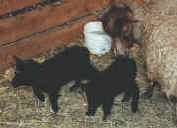Even
though Shetlands are considered a British breed, the Shetland sheep in Canada and the
United States have roots going back over a thousand years to Scandinavia. Norse
settlers probably brought the ancestors of our Shetlands to the Shetland Isles. Many
of the terms still used to describe Shetland colours and patterns resemble words found in
the Old Norse/ Norn languages, Shetland sheep are part of the Northern
European short-tailed group along with the Finnsheep, Norwegian Spaelsau, Icelandics,
Romanovs and others. Shetlands were first imported from the U.K. to Canada (the Flett
flock in Saskatchewan and the Dailley flock in Ontario) and have now spread throughout
North America. There are Shetland breeders in almost every Province and State. A recent
importation of purebred Shetland semen from the U.K. to the U.S. will compliment the
established bloodlines from the original importations.
Shetlands are classed as a
landrace or "unimproved" breed. This characterization is borne out by their
ability to survive, thrive and procreate with little intervention from their human
friends. They are small and slow growing but retain their traits of hardiness,
thriftiness, longevity and adaptability. The ewes are generally easy lambers, good mothers
with plenty of milk and can be fiercely protective of their lambs. Twins are common and
with triplets also occurring and most are raised without difficulty by the ewes. |
 |
The Shetland is the smallest of the British breeds. Rams
usually weigh 40 to 55 kilos (90 to 125 pounds) and ewes about 35 to 45 kilos (75 to 100
pounds). They are fine-boned and their naturally short, fluke-shaped tails do not require
docking. They are very efficient foragers and feed converters and do well on much less
than most larger, improved breeds of sheep. Rams usually have spiral horns, whereas most
ewes are polled. Many of the sheep have friendly dispositions and some even wag their
tails when given a chin scratch.
While renowned for their fine wool and a handspinner's delight, Shetlands
can also be used as a dual purpose breed. They can be crossed with an early maturing
terminal sire (such as a Ryeland or a Dorset). The fat crossbred lambs make excellent
eating and dress out well. In addition, purebred Shetland meat rates high on taste and
fits in well with modern trends toward smaller, leaner cuts of meat. However, it is slow
to mature. Wethers are often held through to yearlings before being shipped for slaughter
due to their smaller carcass size.
The North American Shetland Sheepbreeders Association is available to
assist breeders of Shetland sheep in North America in maintaining the purity and quality
of the breed and to provide accurate registration and pedigree records for informed
breeding decisions. Fibre Works Farm is a member of NASSA and is registered as Flock
number 589.
North American
Shetland Sheepbreeders Association
265 Truway Road
Luxemburg, WI, 54217
USA
Phone (920) 837-2167
NASSA maintains the Shetland Sheep Registry in North America, publishes
an annual flock book and provides members with a very informative and educational
quarterly newsletter.
The breed society for the Shetland Islands is the Shetland Flock Book
Society. On the mainland U.K. the Shetland Sheep Breeders Group (SSBG) act as the breed
society. Breed standards used by the various associations are based on the breed standard
set in the 1920s.
Purebred Shetland numbers have been increasing in recent years and they
have now been reclassified from a 'rare breed' to a 'minority breed' under the Rare Breeds
Survival Trust (RBST). This is no doubt due to the dedication and work of many Shetland
breeders determined to preserve the heritage and the worth inherent in the Shetland breed.